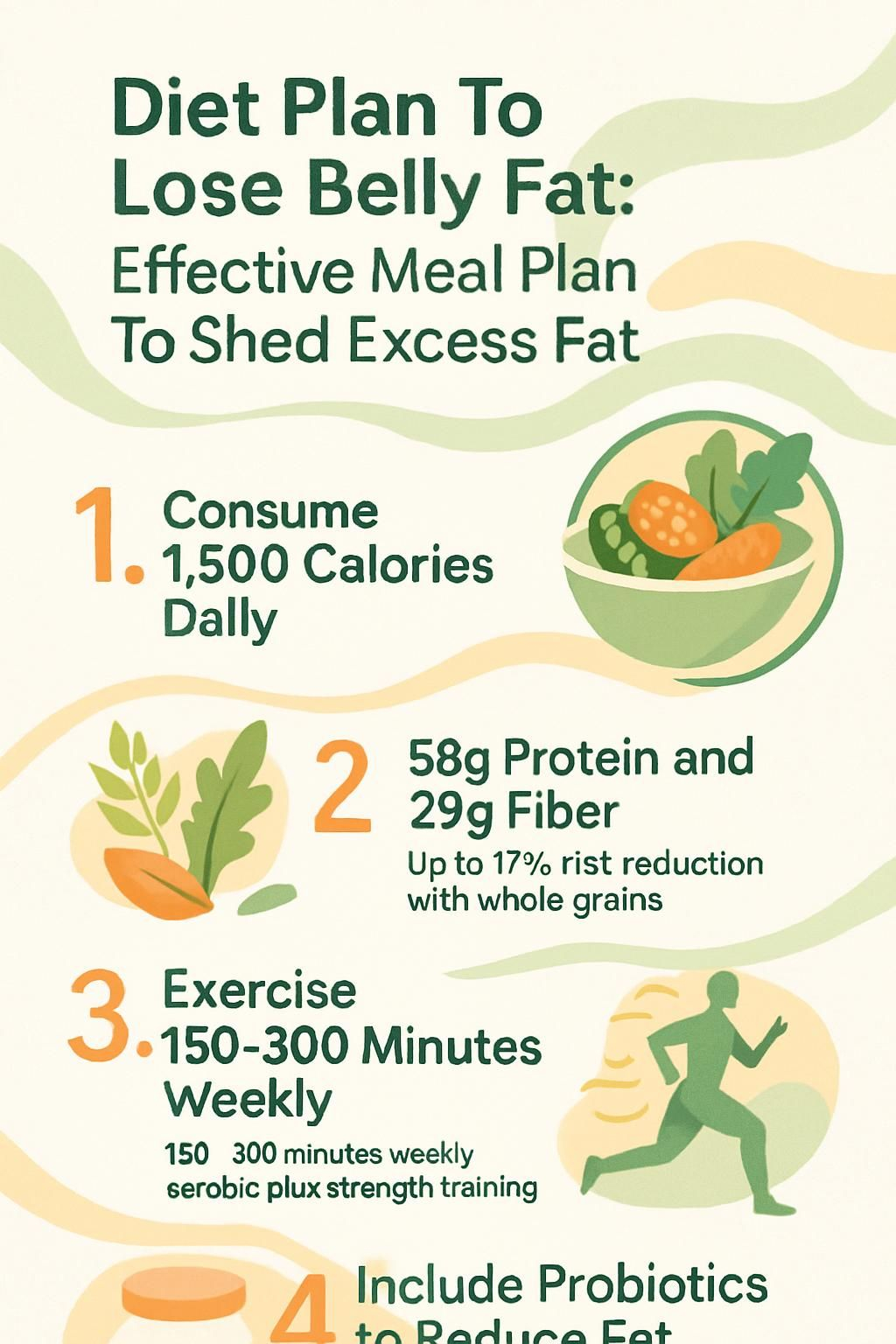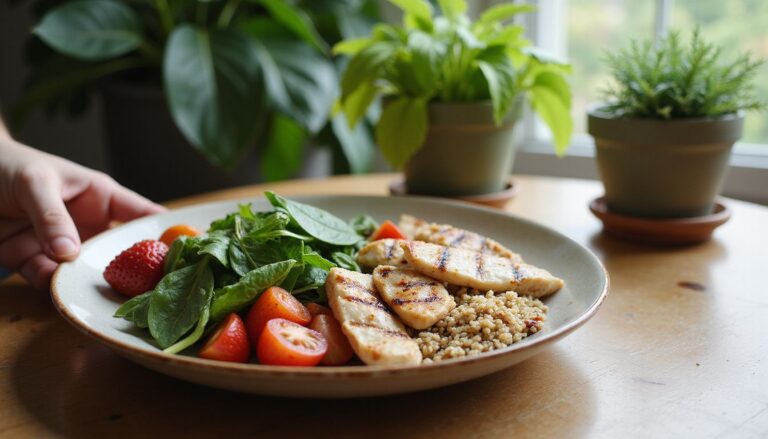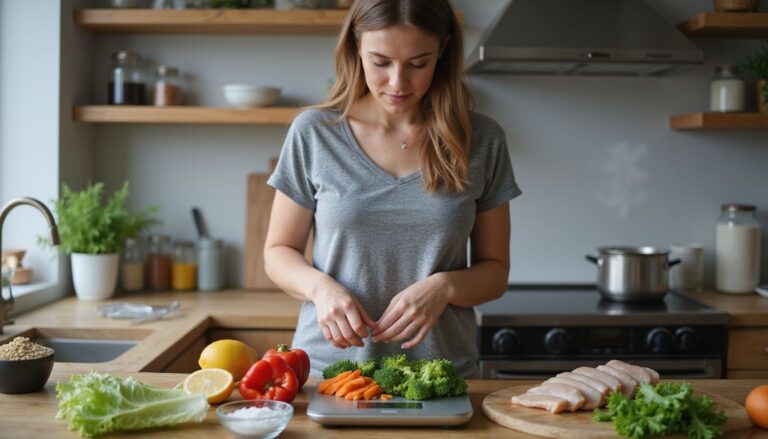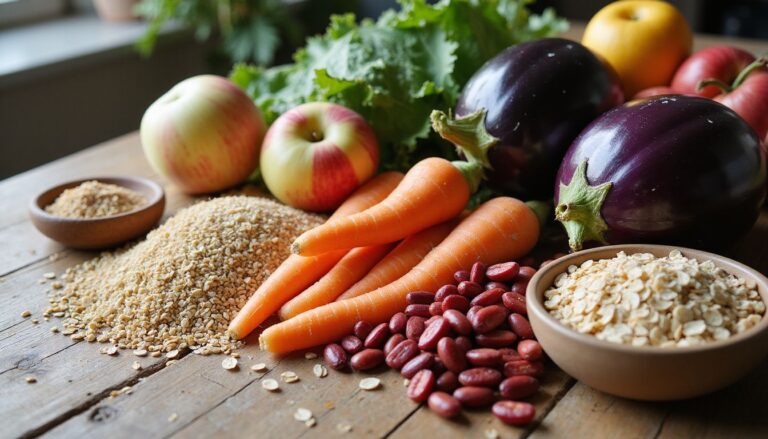Diet Plan To Lose Belly Fat: Effective Meal Plan To Shed Excess Fat
Our Nutrition Assistant AI Suite will transform your body. You will lose fat, get toned, and build muscle. Gain confidence and optimal health.
Finding a realistic diet plan to lose belly fat is hard, especially when life is busy. Extra fat around your waist raises the risk of heart disease and type 2 diabetes. This guide gives you a simple meal plan, smart food swaps, and habits that help you lose weight around your abdomen while protecting your health.
Small changes add up. Start with food choices you can keep, then build steady results week by week.
Key Takeaways
- A daily meal plan near 1,500 calories with at least 58 grams of protein and 29 grams of fiber reduces belly fat more effectively (Recchia et al., 2023).
- Replacing refined carbs with whole grains can cut abdominal obesity risk by up to 17 percent. Added sugars and trans fats raise that risk (McKeown NM et al., 2010; Pipoyan D et al., 2021).
- Combining aerobic exercise and strength training for 150 to 300 minutes per week leads to greater visceral fat loss (Emamat et al., 2024; Spring B et al., 2013).
- Regular intake of probiotic foods, especially Lactobacillus strains, may help reduce subcutaneous belly fat (Mo SY et al., 2022).
- Consistent sleep under five hours increases abdominal weight gain. Stress and high cortisol also drive visceral fat storage (Xu X et al., 2024).

What Are the Different Types of Belly Fat and Their Risks?

Belly fat is not all the same. Different types carry different risks. Knowing the difference helps you target the right habits and improve long-term health.
What Is Subcutaneous Belly Fat?
Subcutaneous fat sits just under your skin. You can pinch it around your waist, hips, and thighs. This fat is less risky than deeper belly fat, though extra amounts can still affect health and comfort.
Genes, hormones, and calorie intake shape where it collects. Puberty and menopause can change its pattern in women. Standard tools can estimate body fat, but body mass index, or BMI, cannot target this layer alone.
Good news; subcutaneous fat usually responds well to balanced meals, higher fiber and protein, and regular physical activity.
You are more likely to reduce subcutaneous belly fat with steady eating habits and consistent exercise.
What Is Visceral Belly Fat?
Visceral fat surrounds your internal organs, including your liver and intestines. It sits deep inside the abdomen, so it is not always visible.
High visceral fat links to insulin resistance, metabolic syndrome, and heart disease. People with a higher visceral to subcutaneous fat ratio face greater cardiovascular risk (Emamat et al., 2024).
Both sleep loss and stress can raise cortisol, a stress hormone, which increases this deep belly fat. Sleep apnea also connects to larger visceral fat stores (Xu X et al., 2024).
Certain foods may help. Fatty fish rich in omega-3s and green tea have been associated with modest reductions in visceral fat. Pair nutrition with activity for best results.
What Health Problems Are Linked to Excess Belly Fat?
Excess belly fat raises the risk of type 2 diabetes, heart disease, and fatty liver disease. Diets high in added sugar, refined carbs, and trans fats drive inflammation and weight gain around the abdomen.
People with larger waists often show higher cortisol during stress, which worsens fat storage near organs. Short sleep, under five hours, predicts weight gain and more abdominal fat. Sleep apnea also aligns with higher visceral fat (Xu X et al., 2024).
Choosing whole, minimally processed foods and building better sleep can lower these risks over time.
Key Principles for Losing Belly Fat
Healthy fat loss rests on a few core principles. These steps help you create a weight loss plan that is realistic and sustainable.
How Does a Caloric Deficit Help Reduce Belly Fat?
A caloric deficit means you eat fewer calories than you burn. Your body then pulls from stored fat for energy, including abdominal fat. Digital food logs improve consistency and outcomes (Spring B et al., 2013).
Structured plans such as the Mayo Clinic Diet suggest early progress with lower calorie meals plus activity. Research shows pairing calorie control with about 1,000 calories per week of exercise can reduce visceral fat (Recchia et al., 2023).
Many people do well near 1,500 calories per day, which supports fat loss while preserving health.
Create a calorie gap with mindful meals and regular movement to shrink abdominal fat.
Why Is Macronutrient Balance Important for Fat Loss?
Macronutrients are protein, fat, and carbohydrate. Getting the right balance improves fullness, protects muscle, and stabilizes blood sugar during a deficit.
Protein from seafood, poultry, eggs, dairy, tofu, and beans increases satiety and helps keep muscle. A 7-day meal plan that includes at least 58 grams of protein and 29 grams of fiber supports steady fat loss and better appetite control.
Healthy fats, like those in avocado and olive oil, increase satisfaction. Omega-3 fats from fish may significantly reduce visceral fat (Salman HB et al., 2022). Whole grains add fiber that steadies energy and curbs cravings.
How Does Physical Activity Affect Belly Fat?
Aerobic exercise burns calories and reduces belly fat, including visceral fat. Higher weekly exercise, near 300 minutes, produced greater fat loss in postmenopausal women compared with 150 minutes.
Teens with excess weight saw the largest drop in visceral fat when they combined cardio and strength training. Resistance work preserves lean muscle, boosts metabolism, and helps your body use fat better.
Start with short sessions if you are new. Even 5 to 10 minutes of brisk walking can build confidence and momentum.
Best Foods to Eat to Reduce Belly Fat
Food choice matters. Focus on fiber, lean protein, healthy fats, and whole grains to reduce belly fat and support your health.
Which High-Fiber Foods Help Lose Belly Fat?
Fiber helps you stay full, supports gut health, and lowers belly fat gain over time.
- Fruits like apples, berries, and pears provide soluble fiber. Every extra 10 grams per day linked to 3.7 percent less belly fat gain over five years (Hairston KG et al., 2011).
- Leafy greens, such as spinach and kale, offer fiber and very few calories.
- Lentils and beans add both fiber and protein, which steady blood sugar and hunger.
- Oats are a high-fiber whole grain tied to less visceral fat than refined grains.
- Barley provides soluble fiber that smooths blood sugar swings and supports energy balance (Hervik AK et al., 2019).
- Broccoli delivers fiber and vitamins that aid digestion and gut health.
- Other legumes, including chickpeas and black beans, improve fullness between meals.
Swap refined breakfast items for oats. Many people find the morning snack cravings fade when fiber goes up.
What Are Good Protein Sources for Belly Fat Loss?
Protein controls hunger and protects muscle while you lose fat. Mix animal and plant sources to fit your taste and ethics.
- Eggs provide high-quality protein that supports muscle and fullness.
- Chicken breast and turkey are lean options suited for many eating styles.
- Fish such as salmon, tuna, and sardines offer protein and heart-friendly fats.
- Beans and lentils give plant protein plus fiber for steady energy.
- Greek yogurt has more protein than regular yogurt and boosts fullness hormones.
- Whey protein can help you reach protein goals on busy days.
- Nuts like almonds and walnuts add protein and healthy fat. Keep portions modest.
- Cottage cheese contains casein, a slow-digesting dairy protein, helpful before bed.
- Lean beef offers iron and B vitamins. Choose cuts low in saturated fat.
Pair a protein-rich breakfast with fiber. This combination helps you avoid mid-morning sugar cravings.
Which Healthy Fats Support Fat Reduction?
Healthy fats improve satiety and can support better metabolism. They also make meals taste great, which helps you stick with your plan.
- Avocado provides fiber, potassium, and unsaturated fats that help you feel full longer.
- Olive oil, a Mediterranean staple, may lower inflammation and support heart health.
- Fatty fish like salmon, mackerel, and sardines provide omega-3 fats that can reduce visceral fat and diabetes risk (Salman HB et al., 2022).
- Algae-based omega-3s are useful if you do not eat fish and may have similar benefits (Lane KE et al., 2022).
- Nuts are linked to smaller waist size and lower metabolic syndrome risk (Cubas-Basterrechea et al., 2022).
- Seeds such as chia and flaxseed add omega-3s and fiber to oats or smoothies.
- Use avocado or olive oil with other nutrient-dense foods for best results.
Healthy fats work best with lean protein, whole grains, and colorful produce.
How Do Probiotic Foods Aid Belly Fat Loss?
Probiotics are friendly bacteria that support gut health. A balanced gut can improve how you use energy and store fat.
- Lactobacillus fermentum, amylovorus, and gasseri may reduce subcutaneous belly fat by improving gut microbiota balance (Mo SY et al., 2022).
- Yogurt, kefir, sauerkraut, and kimchi are rich sources that aid digestion and nutrient absorption.
- Greater gut diversity relates to better insulin sensitivity and weight regulation.
- Studies link probiotic intake to improved markers for diabetes and heart risk due to lower inflammation.
- Health agencies encourage adding probiotic foods to a balanced eating plan.
- Whole foods with fiber and protein boost probiotic benefits more than supplements alone.
- Talk with your clinician before starting probiotic supplements, especially if you have a health condition.
- Eating a variety of fermented foods matches current dietary guidelines in the United States.
- Better gut health may also lower cortisol, which is tied to belly fat storage during stress.
- Green tea plus probiotics may further improve fat metabolism in emerging research.
What Whole Grains Are Beneficial for Losing Belly Fat?
Whole grains keep the bran and germ, which pack fiber, vitamins, and minerals. They help curb hunger and reduce abdominal fat risk.
- Oats deliver beta-glucan, a soluble fiber that boosts fullness.
- Barley blunts blood sugar spikes and may lower abdominal adiposity.
- Brown rice is a higher fiber swap for white rice with more nutrients.
- Quinoa provides complete protein plus fiber for satiety.
- Millet is versatile and helps you avoid refined carbohydrates.
- Whole grain rye increases fullness and may lower total abdominal fat.
- Whole grain bread or wraps beat refined options for fiber and nutrients.
- Amaranth adds minerals like magnesium that support energy and muscle function.
- Use 100 percent whole wheat pasta to raise fiber and support vascular health.
- A 7-day plan that includes oats or barley daily mirrors research showing a 17 percent lower rate of abdominal obesity with higher whole grain intake (McKeown NM et al., 2010).
Foods to Avoid When Trying to Lose Belly Fat
Certain foods make fat loss harder. Cutting back on these items supports your calorie target and your health.
Why Avoid Processed and Sugary Foods?
Ultra-processed foods often pack added sugar, unhealthy fats, and little fiber. They drive up calories fast and offer weak satiety.
In a controlled study, people ate more calories on an ultra-processed diet than on minimally processed meals (Hall KD, 2021). Sugary drinks and juices add a lot of sugar without fullness. An 8-ounce glass of apple juice has about 24 grams of sugar, much of it fructose.
High sugar intake links to more belly fat, higher heart risk, and greater odds of diabetes. Limiting soda, sweet snacks, and packaged desserts supports a calorie deficit and a flatter waist over time.
What Are the Dangers of Trans Fats and Fried Foods?
Trans fats form when oils are hydrogenated to make them solid. Labels list them as partially hydrogenated oils. These fats raise LDL, the bad cholesterol, and lower HDL, the good cholesterol.
Higher trans fat intake increases inflammation and chronic disease risk. Research also links trans fats to more abdominal fat gain (Pipoyan D et al., 2021). Fried foods often contain trans fats because oils are reused at high heat, and they add many calories with little nutrition.
Switching to cooking methods like baking, grilling, or air frying can reduce bloating and support heart health.
Why Limit Refined Carbohydrates?
Refined carbs, such as white bread and pastries, spike blood sugar and fade quickly, which leaves you hungry again. High intakes increase inflammation and insulin resistance, especially in people with overweight, prediabetes, or PCOS.
Whole grains help manage appetite and can reduce belly fat over time. Many people notice fewer cravings and steadier energy after swapping white pasta for brown rice or quinoa.
Choosing unprocessed starchy foods such as sweet potatoes, oats, and barley supports long-term weight management.
How Do Sugary Drinks Affect Belly Fat?
Sugary drinks, including soda, punch, sweet tea, and alcohol mixers, add many calories with almost no satiety. They are linked to higher risk for diabetes and metabolic syndrome (Tseng TS, 2021).
Fruit juice also contains a lot of sugar. Regular intake relates to weight gain (Gill JMR et al., 2014). Replace these with water, seltzer, or unsweetened tea. Follow alcohol limits, up to two drinks a day for men and one for women, to control calories and belly fat.
Example 7-Day Belly Fat-Reducing Meal Plan
A structured 7-day meal plan removes guesswork. Use these ideas as a template, then adjust portions to match your calorie target.
What Should You Eat for Breakfast, Lunch, and Dinner on Day 1?
Start with balanced meals that steady blood sugar and keep you full. The sample menu for Day 1 provides about 1,519 calories, 77 grams protein, 152 grams carbs, and 35 grams fiber.
- Breakfast: Scrambled eggs with sautéed spinach in olive oil. Add whole grain toast with smashed avocado.
- Snack: Crunchy bell pepper slices and a banana for fiber and potassium.
- Lunch: Grilled chicken breast over mixed greens with tomatoes and cucumbers. Dress lightly with extra-virgin olive oil.
- Snack: A small handful of almonds or walnuts for healthy fats and protein.
- Dinner: Herb-baked salmon, roasted Brussels sprouts, and quinoa for protein, omega-3s, and complex carbs.
- Beverages: Water or unsweetened tea to support hydration and appetite control.
- Dessert: Fresh berries or a small square of dark chocolate, under 75 calories.
Protein, fiber, and whole grains work together to boost fullness while you learn new habits.
How to Start Day 2 with High-Fiber Foods and Healthy Fats?
Day 2 keeps fiber high and includes healthy fats for steady energy.
- Choose oats or whole grain toast at breakfast for 4 or more grams of fiber.
- Add avocado or a small serving of nuts for satisfying fats.
- Include Greek yogurt or eggs to support muscle while cutting fat.
- Pick fruit like berries or an apple for vitamins and extra fiber.
- Drink water or herbal tea to support digestion and metabolism.
- Pack snacks like plain yogurt or cut fruit to prevent vending machine runs.
- Balance plates with fiber, protein, and healthy fats to improve satiety.
These steps make your plan easier to follow on busy days.
What Are Low-Carb and Lean Protein Options for Day 3?
Day 3 highlights low-carb meals with lean proteins for appetite control.
- Eat eggs or egg whites at breakfast for a protein jump start.
- Use skinless chicken breast or turkey for lunch or dinner.
- Add lentils or chickpeas for plant protein and extra fiber.
- Load plates with non-starchy vegetables like broccoli and peppers.
- Use olive oil for dressing or light cooking to support fullness.
- Limit carbs to measured portions of quinoa or brown rice.
- Snack on hard-boiled eggs or Greek yogurt for steady energy.
- Measure portions to stay within your calorie deficit.
- Drink water often to help with appetite regulation.
- If vegetarian, swap poultry for tofu or tempeh with similar protein totals.
- Careful planning on this day makes afternoon cravings much easier to handle.
How to Include Whole Grains and Healthy Snacks on Day 4?
Day 4 blends whole grains with smart snacks that are easy to pack and eat.
- Choose oatmeal or barley at breakfast to boost fiber and energy.
- Build lunch with brown rice or quinoa plus chicken or beans.
- Snack on raw nuts, Greek yogurt, or hummus with sliced vegetables.
- Skip refined grain snacks and pick whole grain options instead.
- Drink water throughout the day. Green tea may offer antioxidant benefits.
- Pre-portion snacks to prevent overeating when hunger hits.
- Pick whole grain wraps for sandwiches with avocado and leafy greens.
- Avoid highly processed snack bars with lots of sugar.
- Use lentil soup or roasted chickpeas for fiber-rich meals or snacks.
This approach raises fiber and protein while lowering added sugar and refined starches.
What Does a High-Protein Breakfast and Balanced Dinner Look Like on Day 5?
Start Day 5 with a high-protein breakfast and end with a balanced dinner. Aim for at least 58 grams of protein across the day.
- Breakfast: Two eggs or three egg whites with spinach for over 12 grams of protein.
- Add 150 grams of Greek yogurt for about 15 grams more protein and calcium.
- Include turkey breast or chicken sausage if desired for another 15 to 20 grams.
- Add half an avocado or a tablespoon of ground flaxseed for healthy fats.
- Choose whole grain toast or steel-cut oats, about half a cup cooked.
- Snack options: Cottage cheese or fortified soy milk for extra protein.
- Dinner: Grilled salmon or baked chicken with roasted vegetables.
- Include a side salad dressed with olive oil and lemon juice.
- Serve quinoa, brown rice, or barley, half a cup, to add fiber.
- Use herbs and citrus for flavor, not high-sodium sauces.
- Target at least 29 grams of fiber using vegetables, legumes, and whole grains.
This day keeps hunger calm and supports muscle while you lose fat.
How to Use Anti-Inflammatory Foods and Hydration on Day 6?
On Day 6, choose foods that help manage inflammation and track fluids. These choices support your heart and waistline.
- Eat fatty fish like salmon or sardines for omega-3 fats.
- Drink green tea for antioxidants that support metabolic health.
- Use olive oil for cooking or dressings to boost healthy fats.
- Snack on almonds or walnuts for more monounsaturated fats.
- Fill half your plate with colorful vegetables at lunch and dinner.
- Drink at least eight glasses of water daily along with unsweetened teas.
- Sample target: 1,455 calories, 70 grams protein, 158 grams carbs, 29 grams fiber, 64 grams fat, and 1,666 mg sodium.
Anti-inflammatory choices are simple habits that pay off over time.
Can You Have Cheat Meals in Moderation on Day 7?
Yes, you can include a small indulgence on Day 7. Keep portions modest so you stay near your weekly targets.
- Do not let a treat derail your calorie and nutrient goals.
- Sample day: 1,510 calories, 84 grams protein, 174 grams carbs, 40 grams fiber, 60 grams fat, and 1,704 mg sodium.
- Enjoy a favorite food in a small serving.
- Pick less processed treats when possible.
- Snacks and desserts fit if they do not push you far above targets.
- Eat fiber and protein before a treat to improve appetite control.
- Moderate alcohol to reduce its effect on belly fat storage.
Planned flexibility helps you stick with your meal plan for the long haul.
Lifestyle Strategies to Support Belly Fat Loss
Your daily habits shape your results. Pair your eating plan with movement, stress control, and quality sleep for a stronger outcome.
How Does Cardio and Strength Training Help Reduce Belly Fat?
Cardio burns calories quickly. A 30-minute run or ride can burn 250 to 400 calories depending on pace and body weight.
Strength training preserves muscle, which keeps your metabolism higher at rest. Studies show combining the two beats cardio alone for shrinking visceral fat. Two or three short lifting sessions per week can make a visible difference.
Many people notice their waist starts to shrink within a few weeks of consistent workouts.
What Are Effective Ways to Manage Stress and Lower Cortisol?
High stress raises cortisol, which increases appetite and belly fat storage. Reducing stress helps your plan work better.
Use aerobic exercise, yoga, or meditation for 10 to 20 minutes a day. Try a short breathing routine before bed to relax.
Set a regular sleep schedule, aiming for at least 7 hours nightly. Better sleep lowers stress reactivity and improves hunger control.
Why Is Quality Sleep Important for Belly Fat Loss?
Sleep controls hormones that manage hunger. Too little sleep raises ghrelin, which increases appetite, and lowers leptin, which signals fullness.
People who sleep under 6 hours have a higher chance of gaining visceral fat and developing diabetes and heart disease. Address sleep apnea with your clinician if you snore or wake unrefreshed.
Regular exercise, stress reduction, and a dark, cool room can all improve sleep quality.
How Can Consistent Meal Prep Boost Fat Loss Efforts?
Meal prep helps you hit calorie and protein targets without guesswork. Cook once, then portion meals for the next few days.
Plan dishes with lean protein, fiber-rich carbs, and vegetables. For example, prepare chicken and quinoa bowls with roasted broccoli. This structure limits last-minute choices and reduces processed snack intake.
Spending even two hours each week on prep can save time, money, and calories.
Common Mistakes to Avoid When Losing Belly Fat
A few frequent mistakes can stall progress. Watch for these and adjust early.
Why Can Overeating Healthy Foods Hinder Fat Loss?
Healthy foods still contain calories. Large portions of nuts, avocado, or whole grains can add up quickly and erase your deficit.
For example, two extra handfuls of almonds can add around 320 calories. Measuring oils, grains, and snacks keeps portions honest and results steady.
Balanced meals increase fullness, but total energy intake still drives fat loss.
What Are the Risks of Skipping Meals or Extreme Fasting?
Skipping meals can trigger cravings and overeating later in the day. It can also reduce nutrient intake and lead to fatigue and poor focus.
Extreme fasting may cause muscle loss, which lowers metabolism. Stable, balanced meals support better blood sugar control and more reliable results.
Choose a routine you can keep. Consistency beats crash tactics every time.
How Does Ignoring Physical Activity Affect Belly Fat Loss?
Without activity, your daily calorie burn drops. This slows progress even if your eating plan is solid.
Regular movement reduces visceral fat, improves insulin sensitivity, and boosts mood. People who mix cardio with strength work see faster waist changes than those who stay inactive.
Find activities you enjoy so exercise becomes a habit, not a chore.
Frequently Asked Questions About Losing Belly Fat
You likely share many of the same questions as other readers. Here are clear answers based on research and practice.
How Long Does It Usually Take to See Belly Fat Loss Results?
Most people notice early changes within two to four weeks. A safe pace is about 1 to 2 pounds per week with a steady calorie deficit and regular activity.
Clothes may fit looser before the scale moves much. Keep your plan consistent, and the results follow.
Is It Possible to Target Belly Fat Specifically?
No, you cannot spot-reduce fat from one area with a single exercise. Crunches strengthen ab muscles, but they do not choose where fat leaves.
Fat loss happens bodywide when you maintain a deficit. A diet rich in soluble fiber, lean protein, and healthy fats supports better results and reduces visceral fat, which carries higher health risks.
Focus on total health habits. Your waistline will reflect that work.
How Does Staying Hydrated Influence Fat Loss?
Water supports the breakdown of fats and carbohydrates. Drinking a glass before meals can help you feel full and eat fewer calories.
Hydration improves exercise performance and replaces high-calorie drinks that add sugar. Fruits and vegetables high in water, like cucumbers and oranges, also help you meet fluid needs.
Track your intake and keep a bottle nearby to make this step easy.
Conclusion
A focused diet plan to lose belly fat works best with simple, repeatable steps. Build meals around fiber-rich foods, lean protein, whole grains, and healthy fats. Limit processed snacks, sugary drinks, and trans fats to protect your heart and metabolism.
Add regular cardio and strength training for stronger results. Make sleep and stress control part of your routine. Use a meal tracker to stay near your calorie target and spot patterns.
This article is for general education. If you have a medical condition, are pregnant, or take medication, talk with a licensed clinician or registered dietitian before changing your eating plan. With steady effort and smart choices, you can reduce visceral fat, lose weight, and improve long-term health.
FAQs
1. What foods should I include in a diet plan to lose belly fat?
A meal plan for reducing abdominal fat should focus on lean proteins like chicken breast, whole grains such as brown rice, and vegetables including spinach or broccoli. Research shows that diets rich in fiber and protein help decrease visceral fat while supporting muscle retention [1]. Limiting added sugars and processed foods also aids weight loss.
2. How many calories do I need each day to shed excess belly fat?
Calorie needs depend on age, gender, activity level, and current body weight. For most adults aiming for gradual fat loss, a daily reduction of 500 to 750 calories from maintenance levels can lead to about one pound of weight loss per week [2]. Tracking intake with food journals or apps helps maintain consistency.
3. Can skipping meals speed up the process of losing abdominal fat?
Skipping meals does not promote healthy or lasting results; it may slow metabolism and increase cravings later in the day. Studies indicate that regular balanced meals support better appetite control and more stable energy levels throughout the day [3].
4. Is exercise necessary along with an effective meal plan for shedding belly fat?
Combining physical activity with dietary changes improves outcomes compared to diet alone. Aerobic activities like brisk walking paired with resistance training enhance calorie burn while preserving lean tissue [4]. In my experience following this approach led to steady progress without feeling deprived.
Summary: A structured eating pattern featuring high-fiber produce, lean meats, and whole grains supports abdominal fat reduction when combined with consistent exercise habits. Regular meals prevent overeating while tracking calories ensures sustained progress toward your goals.
References:
[1] Slavin JL & Lloyd B (2012). Health benefits of fruits and vegetables.
[2] NIH: Healthy Weight – Losing Weight.
[3] Farshchi HR et al., (2005). Decreased metabolic rate after breakfast omission.
[4] Ross R et al., (2000). Reduction in obesity via exercise vs caloric restriction.







